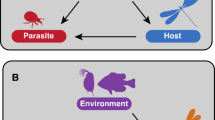Abstract
Darwin1 proposed that secondary sexual characters, such as the long tails and bright plumage of many birds, evolved because females use them as cues in male choice. The question of why females should prefer males with such apparently deleterious characters is currently the subject of vigorous debate2–7. Hamilton and Zuk8 suggest that females use secondary sexual characters to assess a male's ability to resist parasites. A prediction of this hypothesis is that male brightness should correlate positively with parasite load across species, and the only evidence advanced in support of the model is Hamilton and Zuk's8 finding that such a correlation exists across North American passerines. But interspecific correlations of this sort can result from phylogenetic associations through common descent or from independent associations with some confounding variable, such as an aspect of behaviour or ecology9–13. Here, I use data on European passerines and an enlarged data set on North American passerines to demonstrate positive relationships between male brightness and parasite prevalence which remain when the effects of taxonomic, behavioural and ecological variables are removed.
Similar content being viewed by others
References
1. Darwin, C. The Descent of Man, and Selection in Relation to Sex (Murray, London, 1871). 2. Partridge, L. & Harvey, P. H. Nature 323, 580–581 (1986). 3. Andersson, M. Evolution 40, 804–816 (1986). 4. Lande, R. Proc. natn. Acad. Sci. U.S.A. 78, 3721–3725 (1981). 5. Kodric–Brown, A. & Brown, J. H. Am. Nat. 124, 309–323 (1984). 6. Kirkpatrick, M. Evolution 36, 1–12 (1982). 7. Maynard Smith, J. /. theor. Biol. 115, 1–8 (1985). 8. Hamilton, W. D. & Zuk, M. Science 218, 384–387 (1982). 9. Harvey, P. H. & Mace, G. M. in Current Problems in Sociobiology 343–362 (Cambridge University Press, 1982). 10. Harvey, P. H. & Glutton–Brock, T. H. Evolution 39, 559–581 (1985). 11. Elgar, M. A. & Harvey, P. H. Functional Ecology 1, 23–36 (1987). 12. Glutton–Brock, T. H. & Harvey, P. H. in Behavioural Ecology. An Evolutionary Approach (eds Krebs, J.R. & Davies, N.B.) 7–29 (Blackwell, Oxford, 1984). 13. Ridley, M. The Explanation of Organic Diversity (Clarendon, Oxford, 1983). 14. Borgia, G. Behav. Ecol. Sociobiol. 19, 355–358 (1986). 15. Baker, R. R. & Parker, G. A. Phil. Trans. R. Soc. Lond. B287, 63–130 (1979). 16. Peirce, M. A. J. natur. Hist. 15, 419–458 (1981). 17. Griener, E. C., Bennett, G. R, White, E. M. & Coombs, R. F. Can. J. Zoo/. 53, 1762–1787 (1975). 18. Collins, W. E., Jeffery, G. M., Skinner, J. C., Harrison, A. J. & Arnold, F. J. Parasitol. 52, 671–673 (1966). 19. Sokal, R. R. & Rohlf, F. J. Biometry 787–795 (Freeman, New York, 1981). 20. Bennett, P. M. thesis, Univ. of Sussex (1986).
Author information
Authors and Affiliations
Rights and permissions
About this article
Cite this article
Read, A. Comparative evidence supports the Hamilton and Zuk hypothesis on parasites and sexual selection. Nature 328, 68–70 (1987). https://doi.org/10.1038/328068a0
Received:
Accepted:
Issue Date:
DOI: https://doi.org/10.1038/328068a0
- Springer Nature Limited
This article is cited by
-
Avian haemosporidian prevalence and its relationship to host life histories in eastern Tennessee
Journal of Ornithology (2016)
-
The interspecific relationship between prevalence of blood parasites and sexual traits in birds when considering recent methodological advancements
Behavioral Ecology and Sociobiology (2012)
-
Meta-analysis and research on host–parasite interactions: past and future
Evolutionary Ecology (2012)
-
Distribution pattern of apicomplexan parasites (Sporozoa: Haemosporida) in Columba livia, Gmelin
Journal of Parasitic Diseases (2011)
-
Flight distance of urban birds, predation, and selection for urban life
Behavioral Ecology and Sociobiology (2008)





